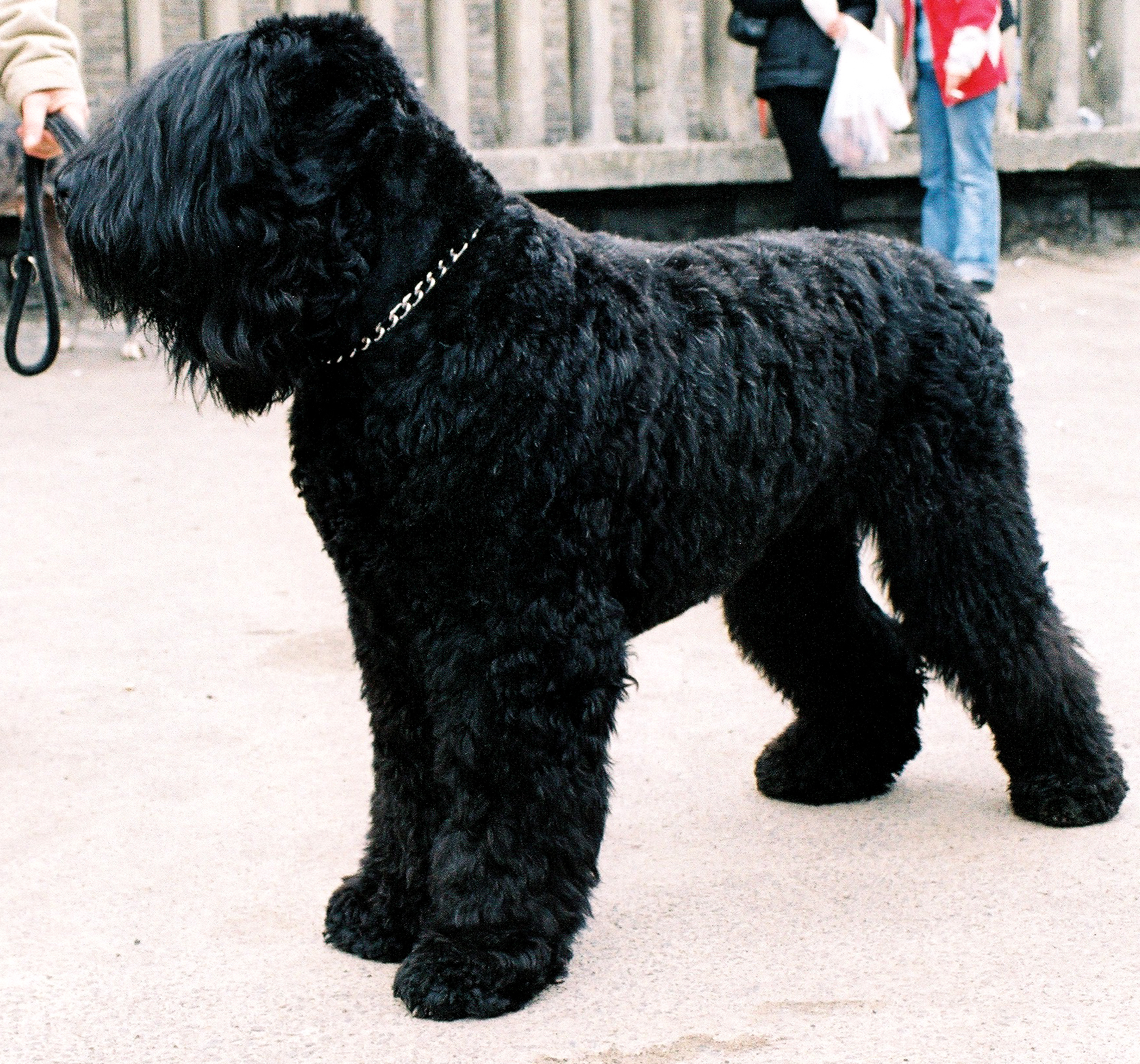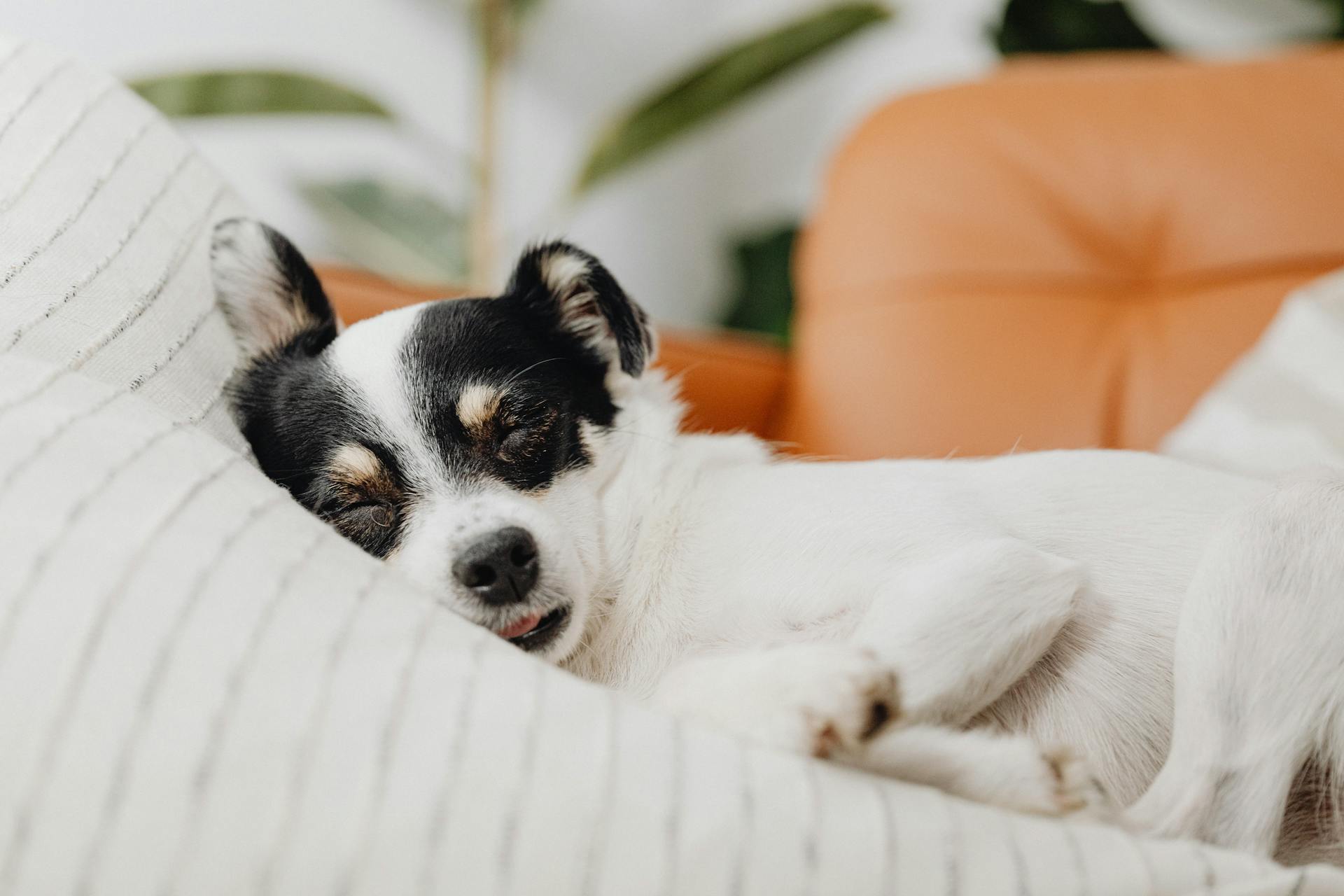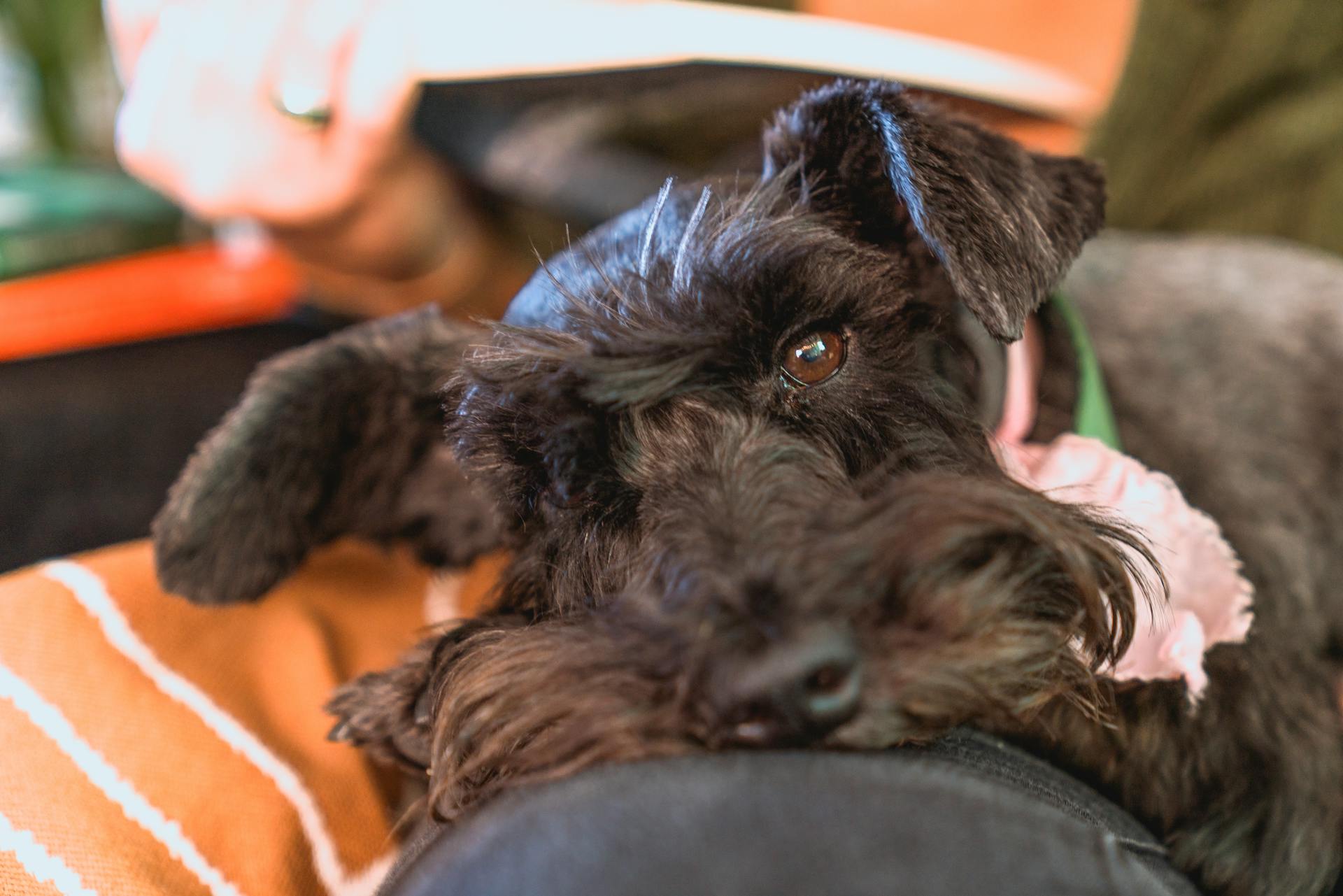
The Black Russian Terrier breed is a majestic sight to behold. They originated from Russia in the 20th century.
Their ancestors were a mix of various breeds, including the Giant Schnauzer and the Rottweiler. This unique blend of bloodlines gave them their distinctive appearance and temperament.
One of the most striking features of the Black Russian Terrier is its thick, double coat. It's designed to keep them warm in freezing temperatures, which they were originally bred for in Russia.
They're naturally protective of their families and can make excellent guard dogs with proper training and socialization.
Breed History and Characteristics
The Black Russian Terrier is a breed with a rich history and impressive characteristics.
Developed in Russia after World War II, this breed was created to serve as an all-purpose military and police dog. The first Black Russian Terriers were exported to the United States in the 1980s and recognized by the AKC in 2004.
The breed's unique pedigree includes influences from 17 breeds, such as the Giant Schnauzer, Rottweiler, Newfoundland, and Airedale. This diverse heritage has contributed to the Black Russian Terrier's adaptability and trainability.
Key characteristics of the Black Russian Terrier include its muscular build, strong bone structure, and distinctive features like a waterproof coat and bearded face.
Here are some key details about the breed's physical appearance:
- Eyes: Oval-shaped, medium-sized, set far apart with black rims.
- Ears: Medium-sized, triangular, set high on the head, hanging down to the cheek with rounded tips.
- Feet: Large, round with black nails.
- Tail: Thick, set high in a sickle shape, sometimes cropped for working dogs.
The Black Russian Terrier's coat is a double-coat, with a coarse outer layer and soft undercoat.
Breed History
The Black Russian Terrier has a fascinating history that spans over six decades.
Developed in Russia after World War II, this breed was created to serve as an all-purpose military and police dog.
The first Black Russian Terriers were exported to the United States in the 1980s.
This impressive breed was developed from 17 different breeds, including the Giant Schnauzer, Rottweiler, Newfoundland, and Airedale.
By 1957, second- and third-generation Black Terriers from Russia were performing tasks such as border guard duty and detecting mines and explosives.
Their adaptability to harsh climates made them ideal for military use.
In 1968, the International FCI registered a breed standard for the Black Russian Terrier.
The AKC recognized the breed in 2004, admitting it into its Working Group.
This recognition marked a significant milestone in the breed's history.
Here's an interesting read: German Military Dogs
Physical Characteristics
The Black Russian Terrier is a majestic breed that's hard to miss. They're large and powerful, with males ranging from 27 to 30 inches in height.
Their massive size is matched only by their impressive weight, which can range from 80 to 145 pounds, with some individuals reaching weights of up to 200 pounds. The life expectancy of this breed is between 10 to 12 years.
One of the most striking features of the Black Russian Terrier is its head, described as "brick-shaped" and moderately broad with well-rounded cheekbones and a flat forehead. A strong, broad muzzle that tapers slightly completes the picture.
The coat of the Black Russian Terrier is a double-coated wonder, with an outer layer of coarse, dense, wavy hair that's basically weatherproof, repelling rain and snow. The soft, short, undercoat protects them from temperature extremes.
Here are some key physical characteristics to keep in mind:
- Eyes: Oval-shaped, medium-sized, set far apart with black rims.
- Ears: Medium-sized, triangular, set high on the head, hanging down to the cheek with rounded tips.
- Feet: Large, round with black nails.
- Tail: Thick, set high in a sickle shape, sometimes cropped for working dogs.
The Black Russian Terrier's coat is also moderately wavy and longer on the face, giving it a bearded appearance. Only black is allowed for conformation, though gray hairs are permissible.
Care and Feeding
The Black Russian Terrier is known for its calm and confident temperament, but they can be aloof with strangers.
To build a strong bond with your Black Russian Terrier, early and consistent socialization is essential to help them feel comfortable around new people, animals, and situations.
Regular exercise, like long walks and interactive playtime, is necessary to keep your Black Russian Terrier mentally stimulated and physically fit.
Despite not being hyperactive, they still require regular physical activity.
Grooming a Black Russian Terrier can be a significant commitment due to their dense double coat, which requires regular brushing to prevent matting and keep their coat healthy.
A slow feeder bowl can help reduce the risk of bloat and GDV by slowing down eating time.
To ensure your Black Russian Terrier gets the right amount of food, measure each meal based on their weight, age, energy level, activity level, and overall health.
Most dog food packaging includes recommended feeding amounts based on weight to help you find the correct amount.
Health Issues
The Black Russian Terrier is generally a healthy breed, but like many large dogs, they can be prone to certain health issues.
Hip dysplasia and heart problems are two potential concerns for this breed. Their lifespan is typically 10-12 years, about average for dogs their size.
A reputable breeder will be honest and open about health problems in the breed and the incidence with which they occur in her lines.
Black Russian Terriers can be prone to orthopedic problems such as hip and elbow dysplasia, eye diseases like cataracts and progressive retinal atrophy, and bloat or gastric torsion.
The Black Russian Terrier Club of America participates in the Canine Health Information Center Program, which requires breeders to have their dogs tested for health issues and publish the results online.
You can check if a breeder's dogs have these certifications on the CHIC website. Do not purchase a puppy from a breeder who cannot provide you with written documentation that the parents were cleared of health problems that affect the breed.
Readers also liked: Hip Dysplasia Bernese Mountain Dog
Here are some common health issues in Black Russian Terriers, along with their risk profile and cost to diagnose and treat:
Allergies are another common health issue in Black Russian Terriers. There are three main types: food allergies, contact allergies, and inhalant allergies.
These allergies can be effectively treated by your veterinarian.
Training and Behavior
Black Russian Terriers are confident dogs that thrive on mental and physical stimulation.
They need at least two walks a day and plenty of playtime in between to keep them happy and healthy.
Games like fetch, frisbee, and tug-of-war are great ways to burn off their excess energy.
Activities like hiking or swimming can also be fantastic outlets for their energetic nature.
Black Russian Terriers do well with consistent positive reinforcement training.
They're smart dogs that learn new commands with ease when trained from a young age and continually reinforced.
Training should start as soon as you bring home your puppy to help them grow into a well-adjusted dog.
Without proper attention, training, and socialization, Black Russian Terriers can develop undesirable behaviors and be fearful around strangers.
Socialization is crucial for this breed, especially with other dogs and people from an early age.
Black Russian Terriers will need to be introduced to new situations and environments to prevent aggression towards other dogs.
Grooming and Maintenance
The Black Russian Terrier's coat is one of its most distinctive features - a dense double coat that requires regular attention to prevent matting and keep it looking its best.
To maintain this impressive coat, you'll need to brush your Black Russian Terrier on a weekly basis. This will help keep their fur healthy and prevent matting.
The outer coat is coarse and wiry, while the undercoat is soft and provides excellent insulation against the elements. Despite being a double-coated breed, they're not heavy shedders, making them a great choice for those with allergies or who prefer less dog hair in their home.
Professional grooming will be necessary every 8 weeks to keep your Black Russian Terrier looking its best. This includes trimming around the ears, beard, and paws.
To keep your Black Russian Terrier's coat healthy and looking good, regular brushing is a must. The frequency of professional grooming may vary depending on the length of their coat.
In terms of overall grooming needs, the Black Russian Terrier requires medium-level attention to maintain its coat and prevent potential health issues. Consistent grooming will help minimize shedding and keep your dog looking its best.
Here are some key grooming tasks for the Black Russian Terrier:
- Brushing: weekly
- Professional Grooming: every 8 weeks
- Nail & Teeth Care: regular attention is necessary to prevent potential health issues.
Exercise and Lifestyle
Black Russian Terriers require a lot of exercise to stay happy and healthy.
They need two half-hour sessions of exercise each day, which can be challenging for some owners. You'll want to make sure you're up for this commitment before bringing one home.
Exercise needs vary depending on climate - they're intolerant of heat, so exercising in hot climates should be done with care.
In colder climates, Black Russian Terriers thrive and can get plenty of exercise outside. They also adapt well to warmer areas as long as they're kept cool during the hottest months.
A daily routine that includes regular physical activity is essential for keeping your Black Russian Terrier healthy and happy.
Despite their size, these dogs are inactive indoors and make great apartment pets if given proper exercise outside.
If you have a yard, consider using it to provide your dog with plenty of space to run around and play.
Some things to keep in mind:
- Daily Exercise: Regular physical activity is essential.
- Indoor Behavior: They are inactive indoors.
Separation anxiety can be a problem for Black Russian Terriers, especially if they're left alone for long periods. This breed needs regular interaction and attention from their family members.
Living with your Black Russian Terrier indoors is ideal, as it allows them to receive the social interaction they need.
Pet Ownership
If you're considering bringing a Black Russian Terrier into your life, be prepared for a loyal companion that thrives in a loving and active environment.
Regular exercise is crucial to prevent boredom, so plan on taking your new furry friend on regular walks and playtime sessions.
The breed's grooming demands are moderate to high, requiring regular brushing to prevent matting and occasional professional grooming.
A commitment to basic obedience training is essential due to the breed's history as guardians.
Adopting a Pet
Adopting a Pet can be a rewarding experience, but it requires patience and research.
Finding the right pet for you means considering factors like temperament and health.
Some breeds, such as Black Russian Terriers, can be challenging to find through rescues and shelters.
You may need to add your name to a waiting list or search extensively to bring one home.
Prioritizing temperament and health during your search will ensure you give your new pet the best possible start in life.
Pet Insurance for
Pet insurance can be a lifesaver for unexpected vet bills. Pet insurance for Black Russian Terriers costs more than for mixed breed dogs.
It's essential to get pet insurance when your dog is still a healthy puppy. This way, you'll have coverage for all breed-specific conditions that may arise later in life.
A typical Black Russian Terrier costs between $1,800 and $2,500, depending on the breeder and location.
Loving Family Member
A Black Russian Terrier craves human attention and will give love back ten times over if you're willing to show them some affection.
These dogs require training and socialization from a young age to bring their temperament into perspective and turn them into loyal family members.
They thrive in loving environments with consistent socialization opportunities, which helps them feel comfortable no matter the situation.
A Black Russian Terrier is protective of all family members and loves to play with children.
Regular exercise and mental stimulation are necessary to prevent boredom, so be prepared to provide plenty of physical and mental activity for your new furry friend.
Grooming demands are moderate to high, requiring regular brushing to prevent matting and occasional professional grooming sessions.
Frequently Asked Questions
Is a Black Russian Terrier a good family dog?
Yes, Black Russian Terriers are loyal and protective family dogs who thrive in loving homes with children. They're calm, confident, playful, and affectionate when off-duty, making them a great addition to many families.
Are black Russian Terriers rare?
Yes, Black Russian Terriers are a relatively rare breed with a limited gene pool. Their unique history makes them an interesting and sought-after companion for dog enthusiasts.
Is a Black Russian Terrier a schnauzer?
While a Black Russian Terrier shares ancestry with the Giant Schnauzer, they are not directly related as the breed was developed through multiple crossings. The Black Russian Terrier is a distinct breed with its own unique characteristics and history.
How much does a Black Russian Terrier cost?
A Black Russian Terrier puppy's cost ranges from $1,000 to $2,500, influenced by factors like bloodline and working abilities. Learn how these factors impact pricing and what to expect when buying a BRT puppy.
Do Black Russian Terriers bark?
Black Russian Terriers are prone to barking if left alone or bored, which can lead to destructive behaviors. If you're considering bringing a BRT home, be prepared for regular interaction and attention throughout the day.
Sources
- https://www.petmd.com/dog/breeds/black-russian-terrier
- https://www.embracepetinsurance.com/dog-breeds/black-russian-terrier
- https://canna-pet.com/breed/black-russian-terrier/
- https://www.petinsurancequotes.com/blog/black-russian-terrier/
- https://www.petful.com/breeds/breed-profile-black-russian-terrier/
Featured Images: pexels.com


